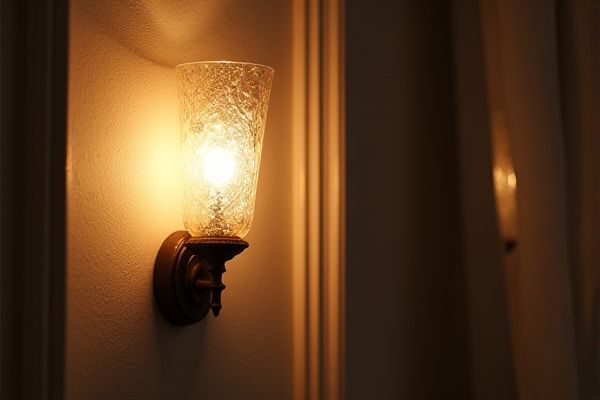
Sconce lighting provides ambient or accent illumination by mounting fixtures on walls, enhancing the overall room atmosphere. Picture lighting specifically highlights artwork or photos, ensuring your pieces stand out; explore the rest of this article to discover which option suits your space best.
Table of Comparison
| Feature | Sconce Lighting | Picture Lighting |
|---|---|---|
| Purpose | General ambient or accent lighting on walls | Highlighting artwork or pictures |
| Placement | Mounted on walls at eye level or higher | Mounted above or on the frame of pictures |
| Light Direction | Upward, downward, or both | Focused directly on artwork |
| Light Intensity | Soft to moderate ambient light | Bright, focused illumination |
| Design Styles | Varies from decorative to minimalistic | Specialized for art enhancement |
| Installation | Simple wall mounting, often hardwired | Usually attached above picture frame, sometimes clip-on |
| Energy Efficiency | Varies with bulb type (LED preferred) | Often LED for focused, efficient lighting |
| Cost | Moderate | Generally higher due to specialized design |
Introduction to Sconce Lighting and Picture Lighting
Sconce lighting features wall-mounted fixtures that provide ambient or accent illumination, enhancing room aesthetics while saving floor space. Picture lighting is specifically designed to highlight artwork, using directed beams to accentuate colors and details without glare. Understanding these lighting types helps you choose the optimal solution to create mood and emphasize focal points in your space.
Defining Sconce Lighting: Features and Styles
Sconce lighting is a wall-mounted fixture designed to provide ambient or accent illumination, often featuring decorative elements that complement various interior styles such as traditional, modern, or industrial. These fixtures typically offer upward or downward light projection, creating atmospheric effects while saving floor and table space. Your choice of sconce lighting can enhance wall aesthetics and functionality by incorporating materials like metal, glass, or fabric in diverse designs to suit different room decors.
Understanding Picture Lighting: Key Characteristics
Picture lighting is designed specifically to highlight artwork or photographs, providing focused illumination that enhances colors and details without causing glare. Its key characteristics include adjustable arms or heads for precise light direction and low heat emission to protect delicate art pieces. You can choose from LED or halogen bulbs, which offer varying intensities and color temperatures to best complement your displayed images.
Placement and Installation: Sconce vs Picture Lighting
Sconce lighting is typically installed on walls at eye level or slightly higher, providing ambient or accent lighting that enhances room decor and architectural features. Picture lighting, on the other hand, is mounted directly above or to the side of artwork to highlight and illuminate paintings or photographs without casting harsh shadows. Your choice between sconce and picture lighting depends on the desired visual impact and the specific placement needs within your space.
Light Distribution and Ambiance Comparison
Sconce lighting offers broader light distribution, casting soft illumination across walls and creating a warm, inviting ambiance in your space. Picture lighting delivers focused, directional light that highlights artwork or photographs without overpowering the room's overall atmosphere. Choosing between the two depends on whether you want general mood enhancement with sconces or precise accentuation using picture lighting.
Energy Efficiency: Analyzing Both Options
Sconce lighting often uses LED bulbs known for high energy efficiency, consuming less power while providing ambient illumination suitable for various settings. Picture lighting typically employs focused LED or halogen bulbs designed to highlight artwork, which can have higher energy consumption due to concentrated beams. Choosing energy-efficient LED fixtures in both sconce and picture lighting significantly reduces electricity usage and environmental impact.
Aesthetic Impact on Room Décor
Sconce lighting creates a warm, ambient glow that enhances the overall atmosphere and architectural features of a room, adding depth and texture to your decor. Picture lighting specifically highlights artwork or photographs, drawing attention to focal points and elevating visual interest without overpowering the space. Choosing between sconce and picture lighting depends on whether you want to emphasize room ambiance or showcase individual pieces.
Practical Applications: Where to Use Each Type
Sconce lighting is ideal for creating ambient or accent lighting in hallways, living rooms, and bedrooms, offering both decorative appeal and functional illumination. Picture lighting is specifically designed to highlight artwork or framed photos, ensuring your art receives focused, even lighting without glare or shadows. For your space, use sconces to enhance overall atmosphere and picture lights to showcase valuable wall displays with precision.
Cost Considerations: Budgeting for Your Lighting
Sconce lighting typically offers a more affordable option with a wide price range depending on design and materials, making it easier to fit various budgets. Picture lighting often involves specialized fixtures and professional installation, increasing overall costs. You can manage your lighting expenses more effectively by comparing these options and selecting styles that meet your budget requirements without sacrificing ambiance.
Choosing the Right Lighting for Your Space
Sconce lighting enhances ambiance by casting warm, indirect light that creates depth and highlights architectural features, making it ideal for hallways or living rooms. Picture lighting specifically directs focused light onto artwork, ensuring colors and details stand out without glare or shadows. Choosing the right lighting for your space depends on whether you want overall mood enhancement or precise illumination to showcase your art collection.
 homyna.com
homyna.com